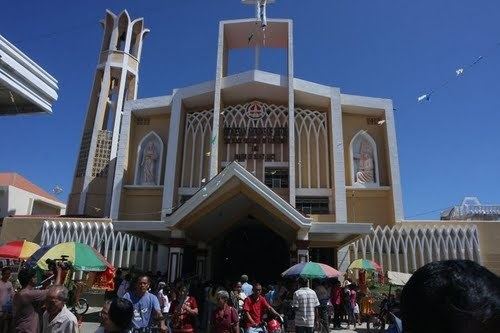Country Philippines District 1st district Time zone PST (UTC+8) Area 290 km² Province Camarines Norte | Region Bicol (Region V) Barangays ZIP code 4607 Local time Wednesday 11:55 PM | |
 | ||
Weather 26°C, Wind NE at 8 km/h, 82% Humidity | ||
Capalonga is a third class municipality in the province of Camarines Norte, Philippines. According to the 2015 census, it has a population of 32,215 people.
Contents
Map of Capalonga, Camarines Norte, Philippines
Barangays
Capalonga is politically subdivided into 22 barangays. In 1955, the sitio of Ilayang Basiad was converted into the barrio of San Pedro.
History
Agtas and Dumagats, are believed to be the first inhabitants of village used to be called "Apalong". This name was derived from a wild plant called "Palong Manok", which looks like a rooster's comb. It is said that whenever the settlers of Apalong went to other places and asked where they came from, the usual reply is "We came from Kapalungan". Historians may comment that the natives were either referring to their place which has many "Palong" (roster's comb) or maybe they wanted identification for their settlement. Whatever it was, no record will show and no one at that time is still living, what is clearly known to Capalongueños is that this place was and still is an environment of flowers called Palong Manok.
In 1572, the Spanish Conquistador Capt Juan de Salcedo and his men reached pacific shores and landed on Kapalongan settlement. Instead of finding gold, they found abundant wild beautiful red flowers that looked like roster's comb. The Spaniards built a church, formed a government, and the village was made a town and officially named Capalonga. The Spaniards for some years persisted on mining for gold at Sitio Maglagonlong, and the Spanish control was described to be brutal, harsh and full of harassment until they went away leaving behind imprints on the community's cultural heritage.
It is also believed that the first migrants of Capalonga came from the neighbouring province of Quezon, formerly Tayabas. This is the reason that out of the twelve (12) municipalities of Camarines Norte, Capalonga has the highest rating and accent in speaking the Tagalog language. However, with the continuous migration process, mixed dialects has been produced. Today, like other places in the country, the dialects of the residents were enriched by various local medium of expression, thereby making no difference from the trend of other political units.
Without roads and being isolated from other towns by mountains, forest, rivers and sea, Capalonga remained relatively undeveloped by commerce and industry as late as the 1950s. In 1956, the road to Capalonga was opened. Still, growth had been slow until Martial law changed the pace. It was in the years 1987 to 1992 that all wooden and temporary bridges have been replaced by concrete bridges. Likewise, in the late part of 2003 up to the present, the paving of the Bagong Silang - Capalonga Road has started and existence of the air-conditioned van transport is now available as a result.
Demographics
In the 2015 census, the population of Capalonga was 32,215 people, with a density of 110 inhabitants per square kilometre or 280 inhabitants per square mile.
